2007 SUBARU IMPREZA oil temperature
[x] Cancel search: oil temperaturePage 265 of 364
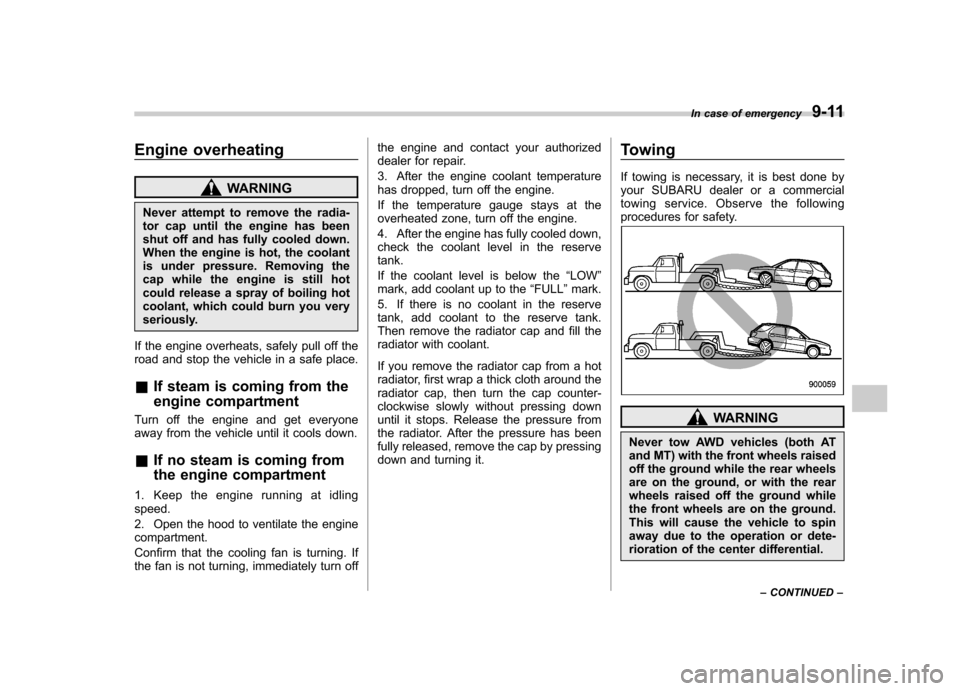
Engine overheating
WARNING
Never attempt to remove the radia-
tor cap until the engine has been
shut off and has fully cooled down.
When the engine is hot, the coolant
is under pressure. Removing the
cap while the engine is still hot
could release a spray of boiling hot
coolant, which could burn you very
seriously.
If the engine overheats, safely pull off the
road and stop the vehicle in a safe place. & If steam is coming from the
engine compartment
Turn off the engine and get everyone
away from the vehicle until it cools down. & If no steam is coming from
the engine compartment
1. Keep the engine running at idling speed.
2. Open the hood to ventilate the engine compartment.
Confirm that the cooling fan is turning. If
the fan is not turning, immediately turn off the engine and contact your authorized
dealer for repair.
3. After the engine coolant temperature
has dropped, turn off the engine.
If the temperature gauge stays at the
overheated zone, turn off the engine.
4. After the engine has fully cooled down,
check the coolant level in the reservetank.
If the coolant level is below the
“LOW ”
mark, add coolant up to the “FULL ”mark.
5. If there is no coolant in the reserve
tank, add coolant to the reserve tank.
Then remove the radiator cap and fill the
radiator with coolant.
If you remove the radiator cap from a hot
radiator, first wrap a thick cloth around the
radiator cap, then turn the cap counter-
clockwise slowly without pressing down
until it stops. Release the pressure from
the radiator. After the pressure has been
fully released, remove the cap by pressing
down and turning it. Towing
If towing is necessary, it is best done by
your SUBARU dealer or a commercial
towing service. Observe the following
procedures for safety.
WARNING
Never tow AWD vehicles (both AT
and MT) with the front wheels raised
off the ground while the rear wheels
are on the ground, or with the rear
wheels raised off the ground while
the front wheels are on the ground.
This will cause the vehicle to spin
away due to the operation or dete-
rioration of the center differential. In case of emergency
9-11
– CONTINUED –
Page 286 of 364
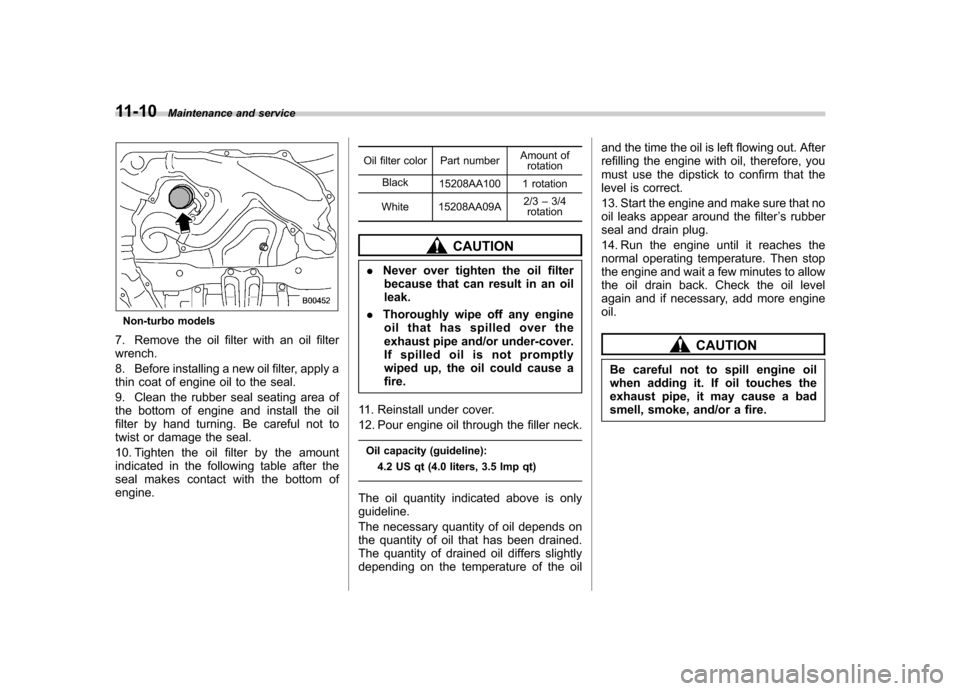
11-10Maintenance and service
Non-turbo models
7. Remove the oil filter with an oil filter wrench.
8. Before installing a new oil filter, apply a
thin coat of engine oil to the seal.
9. Clean the rubber seal seating area of
the bottom of engine and install the oil
filter by hand turning. Be careful not to
twist or damage the seal.
10. Tighten the oil filter by the amount
indicated in the following table after the
seal makes contact with the bottom of engine. Oil filter color Part number
Amount of
rotation
Black 15208AA100 1 rotation
White 15208AA09A 2/3
–3/4
rotation
CAUTION
. Never over tighten the oil filter
because that can result in an oil leak.
. Thoroughly wipe off any engine
oil that has spilled over the
exhaust pipe and/or under-cover.
If spilled oil is not promptly
wiped up, the oil could cause afire.
11. Reinstall under cover.
12. Pour engine oil through the filler neck. Oil capacity (guideline): 4.2 US qt (4.0 liters, 3.5 Imp qt)
The oil quantity indicated above is only guideline.
The necessary quantity of oil depends on
the quantity of oil that has been drained.
The quantity of drained oil differs slightly
depending on the temperature of the oil and the time the oil is left flowing out. After
refilling the engine with oil, therefore, you
must use the dipstick to confirm that the
level is correct.
13. Start the engine and make sure that no
oil leaks appear around the filter
’s rubber
seal and drain plug.
14. Run the engine until it reaches the
normal operating temperature. Then stop
the engine and wait a few minutes to allow
the oil drain back. Check the oil level
again and if necessary, add more engineoil.
CAUTION
Be careful not to spill engine oil
when adding it. If oil touches the
exhaust pipe, it may cause a bad
smell, smoke, and/or a fire.
Page 287 of 364
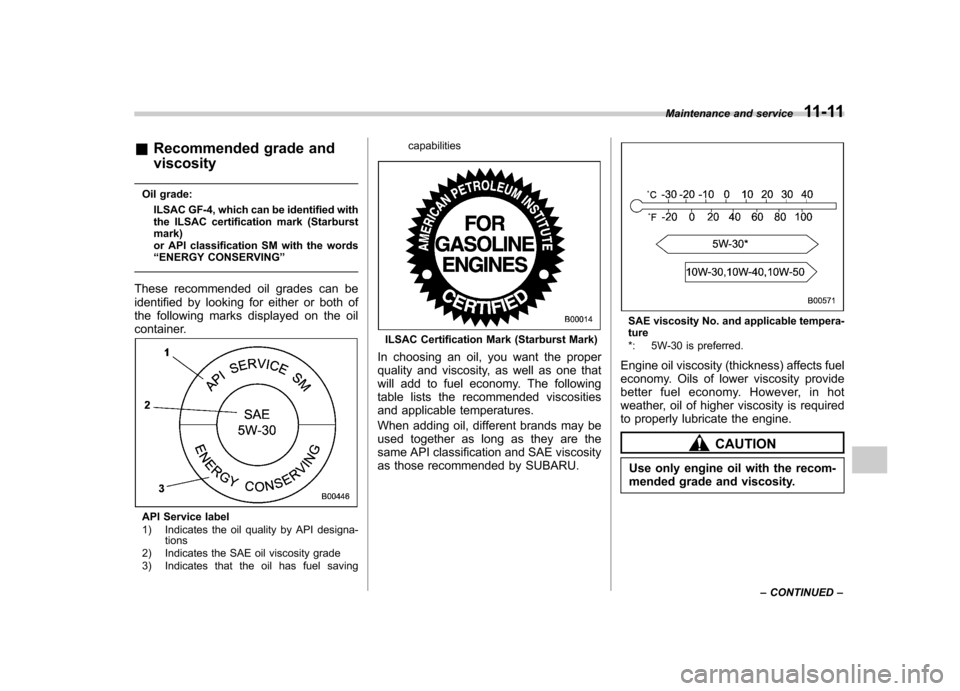
&Recommended grade and viscosity
Oil grade: ILSAC GF-4, which can be identified with
the ILSAC certification mark (Starburst mark)
or API classification SM with the words“ENERGY CONSERVING ”
These recommended oil grades can be
identified by looking for either or both of
the following marks displayed on the oil
container.
API Service label
1) Indicates the oil quality by API designa- tions
2) Indicates the SAE oil viscosity grade
3) Indicates that the oil has fuel saving capabilities
ILSAC Certification Mark (Starburst Mark)
In choosing an oil, you want the proper
quality and viscosity, as well as one that
will add to fuel economy. The following
table lists the recommended viscosities
and applicable temperatures.
When adding oil, different brands may be
used together as long as they are the
same API classification and SAE viscosity
as those recommended by SUBARU.
SAE viscosity No. and applicable tempera- ture
*: 5W-30 is preferred.
Engine oil viscosity (thickness) affects fuel
economy. Oils of lower viscosity provide
better fuel economy. However, in hot
weather, oil of higher viscosity is required
to properly lubricate the engine.
CAUTION
Use only engine oil with the recom-
mended grade and viscosity. Maintenance and service
11-11
– CONTINUED –
Page 288 of 364
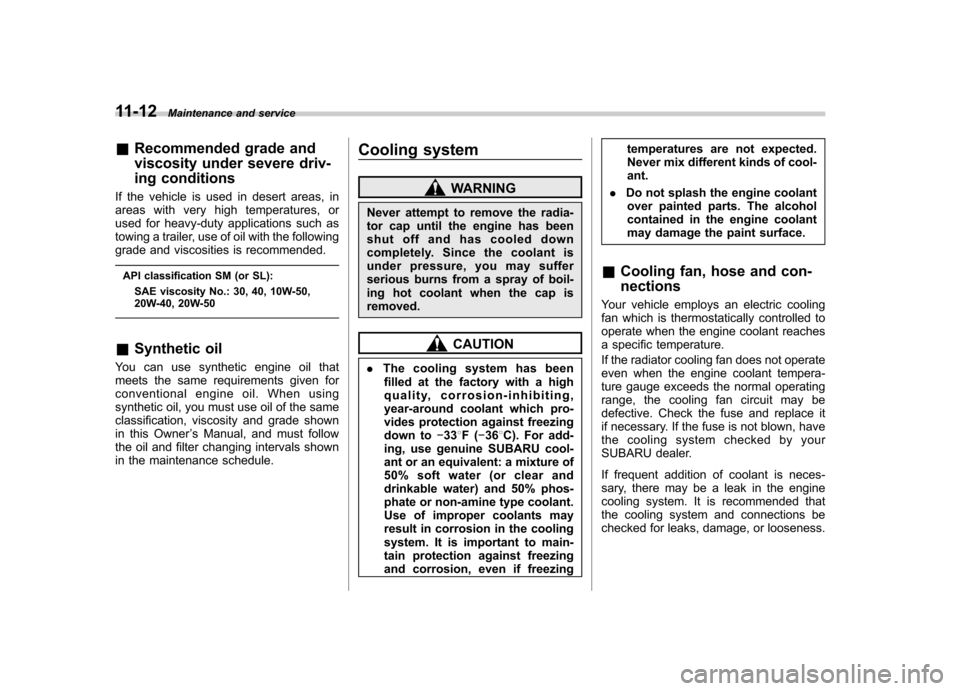
11-12Maintenance and service
&Recommended grade and
viscosity under severe driv-
ing conditions
If the vehicle is used in desert areas, in
areas with very high temperatures, or
used for heavy-duty applications such as
towing a trailer, use of oil with the following
grade and viscosities is recommended.
API classification SM (or SL): SAE viscosity No.: 30, 40, 10W-50,
20W-40, 20W-50
& Synthetic oil
You can use synthetic engine oil that
meets the same requirements given for
conventional engine oil. When using
synthetic oil, you must use oil of the same
classification, viscosity and grade shown
in this Owner ’s Manual, and must follow
the oil and filter changing intervals shown
in the maintenance schedule. Cooling system
WARNING
Never attempt to remove the radia-
tor cap until the engine has been
shut off and has cooled down
completely. Since the coolant is
under pressure, you may suffer
serious burns from a spray of boil-
ing hot coolant when the cap isremoved.
CAUTION
. The cooling system has been
filled at the factory with a high
quality, corrosi on-inhibiting,
year-around coolant which pro-
vides protection against freezing
down to �33 8F( �36 8C). For add-
ing, use genuine SUBARU cool-
ant or an equivalent: a mixture of
50% soft water (or clear and
drinkable water) and 50% phos-
phate or non-amine type coolant.
Use of improper coolants may
result in corrosion in the cooling
system. It is important to main-
tain protection against freezing
and corrosion, even if freezing temperatures are not expected.
Never mix different kinds of cool-ant.
. Do not splash the engine coolant
over painted parts. The alcohol
contained in the engine coolant
may damage the paint surface.
& Cooling fan, hose and con- nections
Your vehicle employs an electric cooling
fan which is thermostatically controlled to
operate when the engine coolant reaches
a specific temperature.
If the radiator cooling fan does not operate
even when the engine coolant tempera-
ture gauge exceeds the normal operating
range, the cooling fan circuit may be
defective. Check the fuse and replace it
if necessary. If the fuse is not blown, have
the cooling system checked by your
SUBARU dealer.
If frequent addition of coolant is neces-
sary, there may be a leak in the engine
cooling system. It is recommended that
the cooling system and connections be
checked for leaks, damage, or looseness.
Page 296 of 364
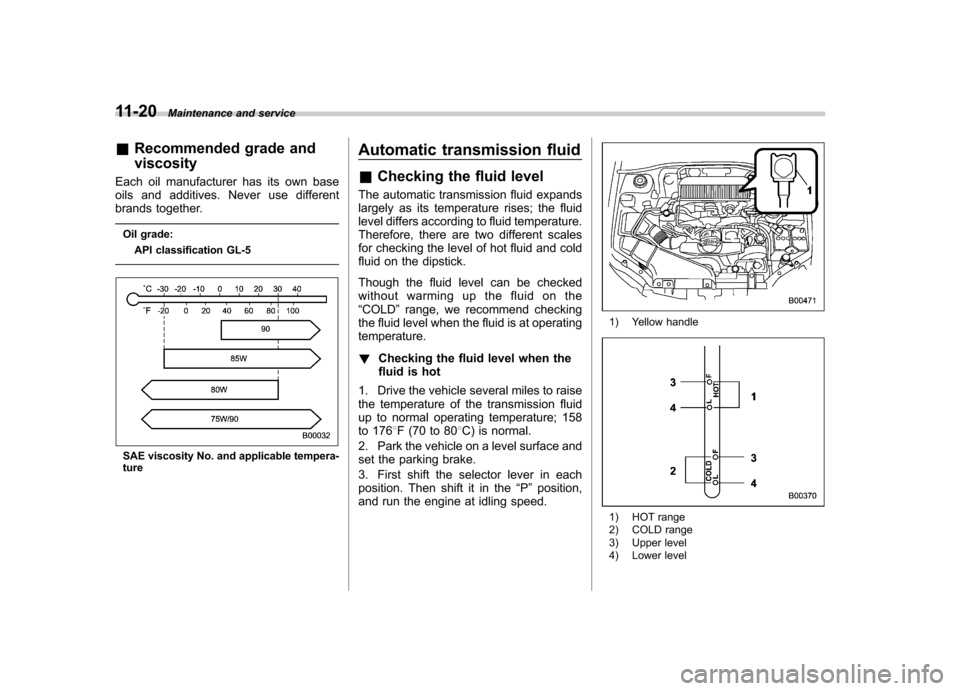
11-20Maintenance and service
&Recommended grade and viscosity
Each oil manufacturer has its own base
oils and additives. Never use different
brands together.
Oil grade: API classification GL-5
SAE viscosity No. and applicable tempera- ture Automatic transmission fluid &
Checking the fluid level
The automatic transmission fluid expands
largely as its temperature rises; the fluid
level differs according to fluid temperature.
Therefore, there are two different scales
for checking the level of hot fluid and cold
fluid on the dipstick.
Though the fluid level can be checked
without warming up the fluid on the“ COLD ”range, we recommend checking
the fluid level when the fluid is at operatingtemperature. ! Checking the fluid level when the
fluid is hot
1. Drive the vehicle several miles to raise
the temperature of the transmission fluid
up to normal operating temperature; 158
to 176 8F (70 to 80 8C) is normal.
2. Park the vehicle on a level surface and
set the parking brake.
3. First shift the selector lever in each
position. Then shift it in the “P ” position,
and run the engine at idling speed.
1) Yellow handle
1) HOT range
2) COLD range
3) Upper level
4) Lower level
Page 300 of 364
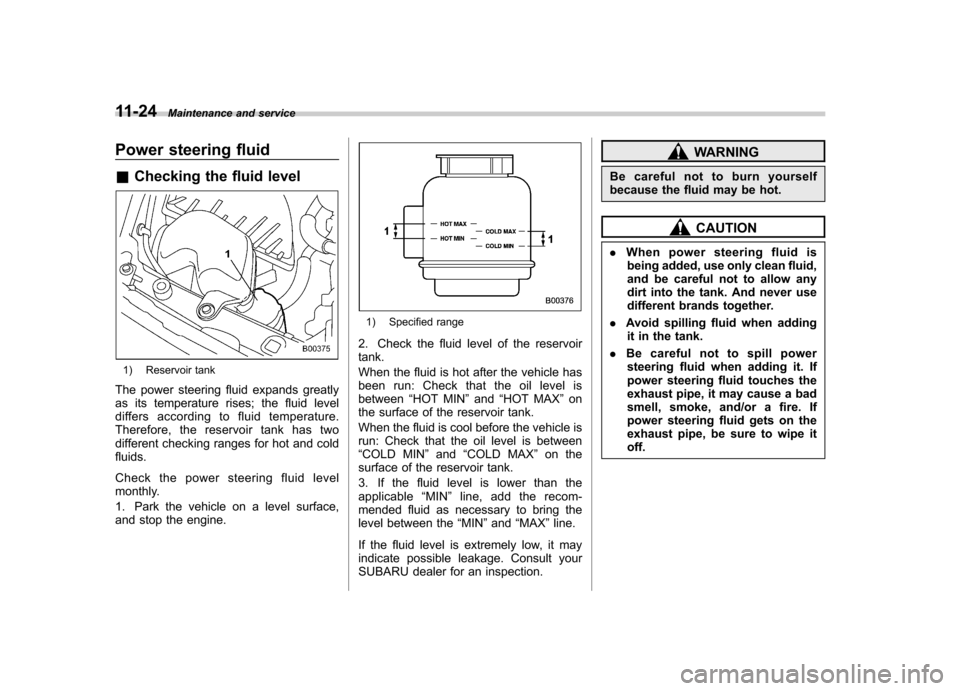
11-24Maintenance and service
Power steering fluid &Checking the fluid level
1) Reservoir tank
The power steering fluid expands greatly
as its temperature rises; the fluid level
differs according to fluid temperature.
Therefore, the reservoir tank has two
different checking ranges for hot and coldfluids.
Check the power steering fluid level
monthly.
1. Park the vehicle on a level surface,
and stop the engine.
1) Specified range
2. Check the fluid level of the reservoir tank.
When the fluid is hot after the vehicle has
been run: Check that the oil level is between “HOT MIN ”and “HOT MAX ”on
the surface of the reservoir tank.
When the fluid is cool before the vehicle is
run: Check that the oil level is between“ COLD MIN ”and “COLD MAX ”on the
surface of the reservoir tank.
3. If the fluid level is lower than the
applicable “MIN ”line, add the recom-
mended fluid as necessary to bring the
level between the “MIN ”and “MAX ”line.
If the fluid level is extremely low, it may
indicate possible leakage. Consult your
SUBARU dealer for an inspection.
WARNING
Be careful not to burn yourself
because the fluid may be hot.
CAUTION
. When power steering fluid is
being added, use only clean fluid,
and be careful not to allow any
dirt into the tank. And never use
different brands together.
. Avoid spilling fluid when adding
it in the tank.
. Be careful not to spill power
steering fluid when adding it. If
power steering fluid touches the
exhaust pipe, it may cause a bad
smell, smoke, and/or a fire. If
power steering fluid gets on the
exhaust pipe, be sure to wipe itoff.
Page 355 of 364
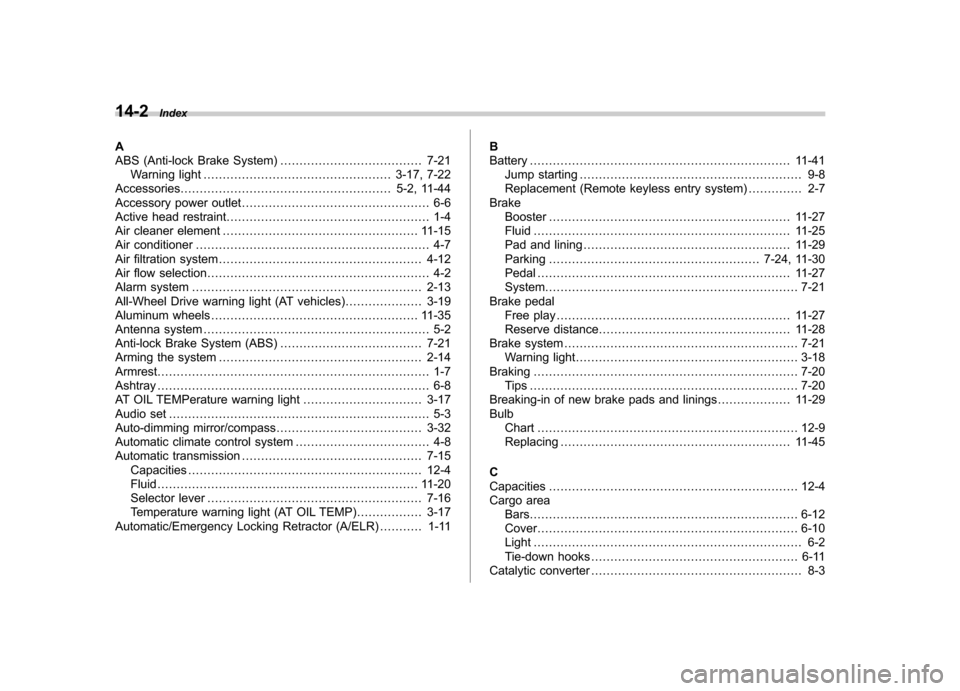
14-2Index
A
ABS (Anti-lock Brake System) ..................................... 7-21
Warning light ................................................. 3-17, 7-22
Accessories ....................................................... 5-2, 11-44
Accessory power outlet ................................................. 6-6
Active head restraint ..................................................... 1-4
Air cleaner element ................................................... 11-15
Air conditioner ............................................................. 4-7
Air filtration system ..................................................... 4-12
Air flow selection .......................................................... 4-2
Alarm system ............................................................ 2-13
All-Wheel Drive warning light (AT vehicles) .................... 3-19
Aluminum wheels ...................................................... 11-35
Antenna system ........................................................... 5-2
Anti-lock Brake System (ABS) ..................................... 7-21
Arming the system ..................................................... 2-14
Armrest ....................................................................... 1-7
Ashtray ....................................................................... 6-8
AT OIL TEMPerature warning light ............................... 3-17
Audio set .................................................................... 5-3
Auto-dimming mirror/compass ...................................... 3-32
Automatic climate control system ................................... 4-8
Automatic transmission ............................................... 7-15
Capacities ............................................................. 12-4
Fluid .................................................................... 11-20
Selector lever ........................................................ 7-16
Temperature warning light (AT OIL TEMP) ................. 3-17
Automatic/Emergency Locking Retractor (A/ELR) ... ........ 1-11BBattery
.................................................................... 11-41
Jump starting .......................................................... 9-8
Replacement (Remote keyless entry system) .............. 2-7
Brake Booster ............................................................... 11-27
Fluid ................................................................... 11-25
Pad and lining ...................................................... 11-29
Parking ....................................................... 7-24, 11-30
Pedal .................................................................. 11-27
System .................................................................. 7-21
Brake pedal Free play ............................................................. 11-27
Reserve distance .................................................. 11-28
Brake system ............................................................. 7-21
Warning light .......................................................... 3-18
Braking ..................................................................... 7-20
Tips ...................................................................... 7-20
Breaking-in of new brake pads and linings ................... 11-29
Bulb Chart .................................................................... 12-9
Replacing ............................................................ 11-45
C Capacities ................................................................. 12-4
Cargo area Bars ...................................................................... 6-12
Cover .................................................................... 6-10
Light ...................................................................... 6-2
Tie-down hooks ...................................................... 6-11
Catalytic converter ....................................................... 8-3
Page 359 of 364
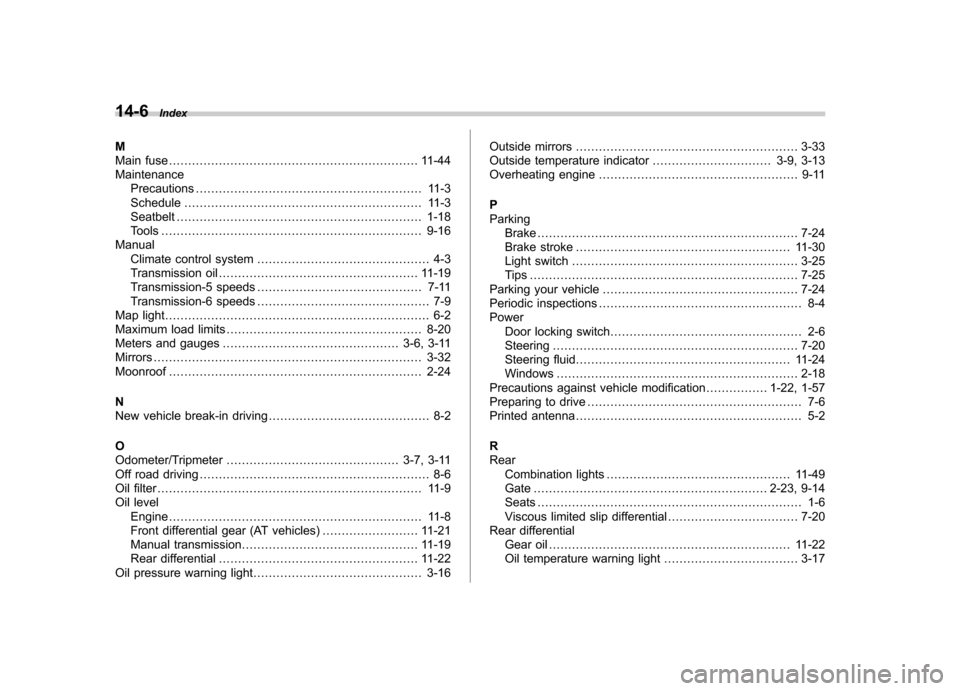
14-6Index
M
Main fuse ................................................................. 11-44
Maintenance
Precautions ........................................................... 11-3
Schedule .............................................................. 11-3
Seatbelt ................................................................ 1-18
Tools .................................................................... 9-16
Manual Climate control system ............................................. 4-3
Transmission oil .................................................... 11-19
Transmission-5 speeds ........................................... 7-11
Transmission-6 speeds ............................................. 7-9
Map light ..................................................................... 6-2
Maximum load limits ................................................... 8-20
Meters and gauges .............................................. 3-6, 3-11
Mirrors ...................................................................... 3-32
Moonroof .................................................................. 2-24
N
New vehicle break-in driving .......................................... 8-2
O
Odometer/Tripmeter ............................................. 3-7, 3-11
Off road driving ............................................................ 8-6
Oil filter ..................................................................... 11-9
Oil level
Engine .................................................................. 11-8
Front differential gear (AT vehicles) ......................... 11-21
Manual transmission .............................................. 11-19
Rear differential .................................................... 11-22
Oil pressure warning light ............................................ 3-16 Outside mirrors
.......................................................... 3-33
Outside temperature indicator ............................... 3-9, 3-13
Overheating engine .................................................... 9-11
P Parking Brake .................................................................... 7-24
Brake stroke ........................................................ 11-30
Light switch ........................................................... 3-25
Tips ...................................................................... 7-25
Parking your vehicle ................................................... 7-24
Periodic inspections ..................................................... 8-4
Power
Door locking switch .................................................. 2-6
Steering ................................................................ 7-20
Steering fluid ........................................................ 11-24
Windows ............................................................... 2-18
Precautions against vehicle modification ................ 1-22, 1-57
Preparing to drive ........................................................ 7-6
Printed antenna ........................................................... 5-2
R Rear Combination lights ................................................ 11-49
Gate ............................................................. 2-23, 9-14
Seats ..................................................................... 1-6
Viscous limited slip differential .................................. 7-20
Rear differential Gear oil ............................................................... 11-22
Oil temperature warning light ................................... 3-17